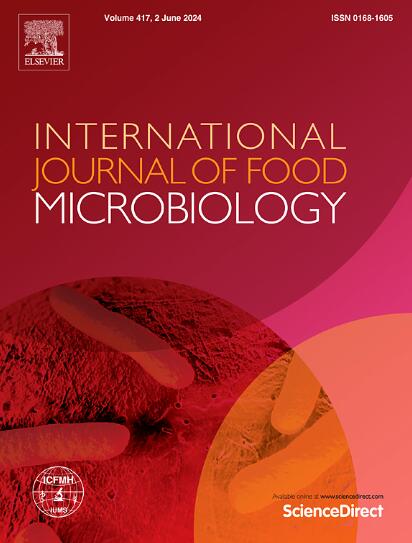曲酸防治番茄采后软腐病及其抑制胡萝卜乳杆菌的可能机制。carotovorum
IF 5
1区 农林科学
Q1 FOOD SCIENCE & TECHNOLOGY
International journal of food microbiology
Pub Date : 2025-07-06
DOI:10.1016/j.ijfoodmicro.2025.111339
引用次数: 0
摘要
软腐病是影响采后番茄的主要细菌性病害。番茄果实被胡萝卜胸乳杆菌感染后。该病迅速发展,导致果实变质。曲酸是传统东方食品发酵过程中几种真菌的天然代谢物。本研究研究了米曲霉发酵产物曲酸对番茄软腐病的防治效果,并探讨了其作用机制。4 mg/mL浓度的曲酸对番茄果实软腐病的防治效果显著,在体内和体外均可直接抑制病原菌的生长,且对番茄品质无不良影响。1/2最小抑制浓度(MIC)、MIC和4 mg/mL的曲酸增加了Pcc细胞膜的通透性,导致细胞内物质渗漏。换句话说,在曲酸处理下,Pcc细胞膜的完整性受到损害。不同浓度的曲酸刺激了Pcc的ROS积累和膜脂过氧化。此外,预测曲酸与DNA通过基于分子对接的三个氢键结合,与溴化乙啶(EB)的结合相似。这扰乱了DNA的正常作用。首次探讨了曲酸对番茄采后软腐病的防治效果,揭示了曲酸对番茄采后软腐病的防治机理。本文章由计算机程序翻译,如有差异,请以英文原文为准。
Control of postharvest soft rot of tomato fruit by kojic acid and the potential mechanisms involved in the inhibition on Pectobacterterium carotovorum subsp. carotovorum
Soft rot is the major bacterial disease affecting postharvest tomatoes. After the tomato fruit is infected by the pathogen, Pectobacterterium carotovorum subsp. carotovorum (Pcc), the disease rapidly develops and leads to fruit deterioration. Kojic acid is a natural metabolite of several fungi during the fermentation process of traditional oriental food. In this study, we investigated the efficacy of kojic acid (fermentation product of Aspergillus oryzae) against tomato soft rot and explored the underlying mechanisms. Kojic acid at the concentration of 4 mg/mL exhibited significant efficacy in controlling tomato fruit soft rot by directly suppressing the pathogen's growth, both in vitro and in vivo, and the application of kojic acid has no adverse effects on the quality of tomatoes. The 1/2 minimal inhibitory concentration (MIC), MIC, and 4 mg/mL of kojic acid increased the permeability of the Pcc cell membrane, resulting in the leakage of intracellular substances. In other words, the integrity of the Pcc cell membrane was compromised upon kojic acid treatment. Kojic acid at different concentrations stimulated ROS accumulation and membrane lipid peroxidation of Pcc. In addition, kojic acid was predicted to bind with DNA through three hydrogen bonds based on molecular docking, and the binding of kojic acid to DNA was similar to that of ethidium bromide (EB). This disturbs the normal role of DNA. The control effect of kojic acid against postharvest soft rot of tomato fruit was explored for the first time, and the mechanisms involved in the inhibition of kojic acid on Pcc was revealed.
求助全文
通过发布文献求助,成功后即可免费获取论文全文。
去求助
来源期刊
CiteScore
10.40
自引率
5.60%
发文量
322
审稿时长
65 days
期刊介绍:
The International Journal of Food Microbiology publishes papers dealing with all aspects of food microbiology. Articles must present information that is novel, has high impact and interest, and is of high scientific quality. They should provide scientific or technological advancement in the specific field of interest of the journal and enhance its strong international reputation. Preliminary or confirmatory results as well as contributions not strictly related to food microbiology will not be considered for publication.

 求助内容:
求助内容: 应助结果提醒方式:
应助结果提醒方式:


